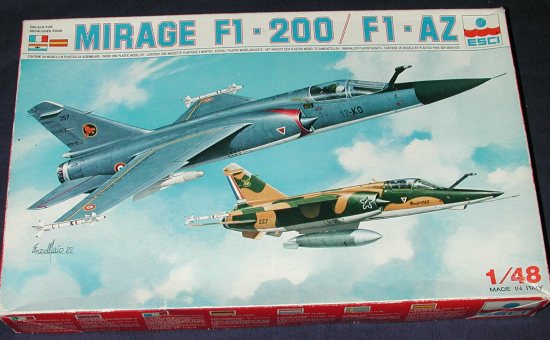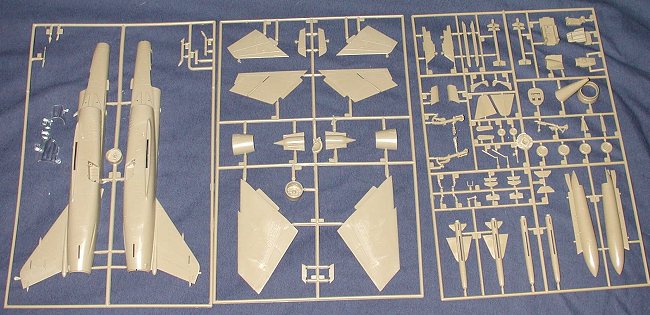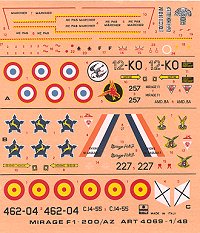
|
KIT: |
ESCI 1/48 Mirage F.1-200/AZ |
|
KIT # |
4069 |
|
PRICE: |
$? |
|
DECALS: |
Three aircraft |
|
REVIEWER: |
|
|
NOTES: |
Long OOP |

|
HISTORY |
After the development of the Mirage III interceptors, the French started looking for a replacement for its US F-100Ds and Super Mysteres in the ground attack role and could also be used as a state of the art interceptor. What came from the Dassault plant was a very 'normal' looking aircraft that dispensed with the delta wing of the earlier Mirage III/V series. Powered by an Atar engine, the Mirage F.1 prototype first flew in 1966. However, due to the usual hassles involved with getting new planes 'right' for the air force, the first production plane did not fly until 1975. It was, however, just what the French were looking for and quickly entered service. It was also built in a a large number of other variants for foreign air forces, each with their own requirements. The aircraft that is the subject of this kit is the -200 version, which basically means it can use a fixed air refueling probe as that feature was not part of the original F.1C interceptor.
|
THE KIT |

Upon looking in the box, it is hard to believe that this is a 20 year old kit. Yet this kit originates in the very early 1980s. It has engraved panel lines that are very crisply done. It also includes a full cockpit and wheel well detail. Now the cockpit does rely on decals for details, and perhaps the seat is a bit basic, but all the right bits are there. Two different versions are able to be built from this kit. One is the F.1-200 with the fixed refueling probe, the other is the one built for South Africa, the F.1AZ. This aircraft has a retractable refueling probe for the nose and is optimized for ground attack as it has no air intercept radar in its very different nose section.
A goodly selection of 'things under wings' is provided, including two Matra
Magic AAMs and two larger missiles whose designation escapes me at the moment. A
large centerline drop tank is also provided. The kit instructions also recommend nose weight and I concur.
kit instructions also recommend nose weight and I concur.
Instructions are very good, as were nearly all ESCI sheets. They offer several excellent construction sequences and offer color information in generic terms and FS 595 numbers as well. Markings are provided for three aircraft, two of which are shown on the box art. First is a French -200 from EC 2/12 'Picardie' in French air superiority blue over silver. This same scheme is used for the Spanish -200 from ALA 14 Esq 462. Most Spanish -200s are now painted in several shades of grey. The South African -AZ is in Olive Drab and 'Oak' over Duck Egg Blue, though these are also probably in a different scheme by now. ESCI decals are quite matte and have a mixed reputation amongst modelers. If you wish to forego any problems with them, then there are several aftermarket sheet from Albatros and Carpena that should fill the bill in this regard.
|
CONCLUSIONS |
Well, it is darn sure that no one is currently planning on doing modern, updated versions of this kit. Italeri has apparently used this set of sprues for its recent reboxing and added some more 'things under wings' to update it to an F.1CR/CT. It really is a decent kit and with a bit of extra detailing, can easily match the newer items.
If you would like your product reviewed fairly and quickly by a site that has well over 175,000 visitors a month, please contact me or see other details in the Note to Contributors.